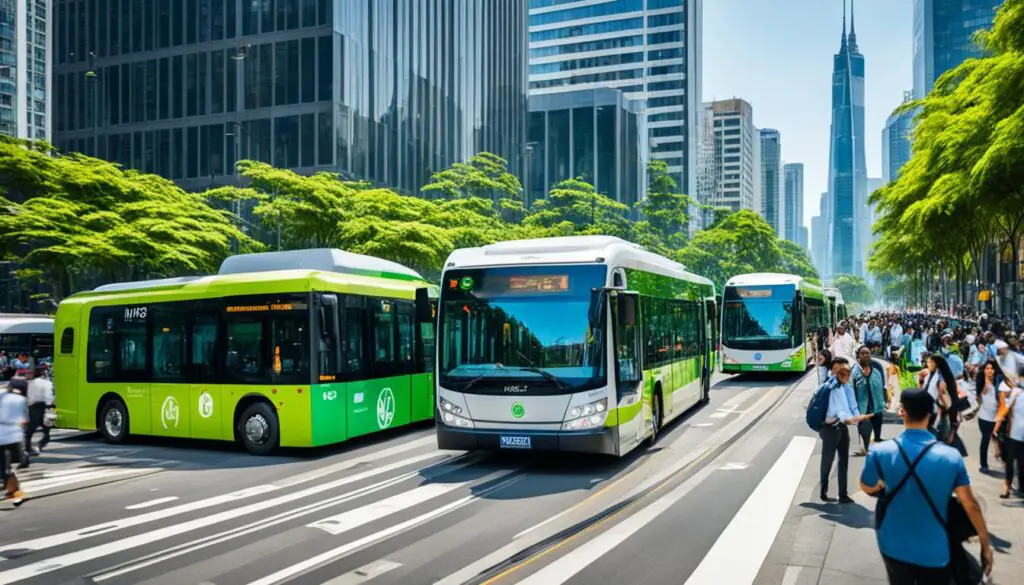Welcome to my guide on zero-emission transportation, where we will explore the various options available for clean travel. With the growing concern for climate change and air pollution, it’s more important than ever to consider greener alternatives for our journeys. Zero-emission transportation offers a cleaner and more sustainable way to travel, helping to reduce our carbon footprint and protect the environment. In this guide, we will delve into the benefits of zero-emission transportation and how it is shaping the future of travel.
Key Takeaways:
- Zero-emission transportation is a greener alternative for travel.
- It helps reduce greenhouse gas emissions and air pollution.
- Electric vehicles, public transportation, cycling and walking, and carpooling/ride-sharing are all viable options.
- These options contribute to a sustainable future and improved air quality.
- By embracing zero-emission transportation, we can all play a part in building a cleaner and greener world.
Electric Vehicles: Driving Towards a Greener Future
Electric vehicles (EVs) are quickly gaining popularity as a zero-emission transportation option. Unlike traditional vehicles powered by fossil fuels, EVs run on electricity, significantly reducing greenhouse gas emissions and air pollution. This shift towards electric transportation is driving us towards a greener future.
One of the main advantages of electric vehicles is the continuous improvement in battery technology. EVs now offer longer ranges and faster charging times, making them a practical choice for everyday use. With advancements in infrastructure and charging stations, the range anxiety once associated with EVs is becoming less of a concern.
Governments and automakers around the world are making significant investments in the development of EV infrastructure. Charging points are now widely available, making it easier for EV owners to charge their vehicles conveniently. This investment not only promotes the adoption of electric vehicles but also encourages the growth of a sustainable transportation network.
- Zero tailpipe emissions, reducing air pollution and improving urban air quality
- Lower fuel and maintenance costs compared to traditional combustion engine vehicles
- Reduced dependence on fossil fuels and increased energy diversity
- Quieter operation, reducing noise pollution in urban areas
As more individuals choose electric vehicles, we move closer to a greener and more sustainable future. The adoption of EVs plays a vital role in combating climate change and reducing our carbon footprint. Together, we can create a cleaner and healthier environment for future generations.
Public Transportation: A Sustainable Choice for Mass Mobility
Public transportation is a vital component of our efforts to reduce emissions and foster sustainable mobility. Mass transit systems, including buses, trains, and trams, offer an efficient means of transporting large numbers of people while minimizing environmental impact. By embracing public transportation as a sustainable choice, individuals can contribute to reducing traffic congestion, cutting carbon emissions, and improving air quality.
Many cities around the world are taking significant strides in expanding their public transportation networks and implementing cleaner technologies. Electric or hybrid buses and trains are fast replacing their fossil fuel-powered counterparts, further enhancing the sustainability of public transportation systems. This transition not only reduces greenhouse gas emissions but also offers a more comfortable and enjoyable travel experience for commuters.
Benefits of Public Transportation:
- Reduces traffic congestion and travel times for individuals
- Decreases carbon emissions and improves air quality
- Minimizes the need for private vehicles, saving individuals money on fuel and parking
- Promotes a sense of community and social interaction among commuters
- Improves accessibility and mobility for individuals without personal vehicles
| Advantages | Disadvantages |
|---|---|
| Reduces carbon emissions | Potential for overcrowding during peak hours |
| Cost-effective compared to private vehicle ownership | Schedules may not always align with individual preferences |
| Lessens traffic congestion | May require additional transfer(s) for reaching certain destinations |
| Promotes healthier and more active lifestyles through walking or cycling to transit stops | May experience delays or disruptions due to maintenance or unforeseen circumstances |
Embracing public transportation as a sustainable choice is not only beneficial for individuals but also for the environment and our communities as a whole. By promoting and investing in public transportation infrastructure, we can create a future where clean and efficient mobility is accessible to all.
Cycling and Walking: Healthy and Emission-Free Options
When it comes to sustainable transportation, there are two options that not only offer emission-free travel but also provide tremendous health benefits – cycling and walking. By choosing these modes of transport, individuals can actively contribute to reducing their carbon footprint while improving their personal well-being.
Cycling is an excellent form of exercise that combines cardiovascular fitness with low impact on the joints. It helps build muscle strength, enhances coordination, and boosts overall fitness. Regular cycling can reduce the risk of obesity, heart disease, and other chronic illnesses. Moreover, it allows individuals to enjoy the outdoors and diverse landscapes while commuting, making it a pleasant and invigorating experience.
Walking, on the other hand, is an accessible physical activity that can be integrated seamlessly into daily routines. It requires no special equipment and can be done anywhere and at any pace. Walking helps improve cardiovascular health, strengthens bones and muscles, and enhances mental well-being. It is a simple and enjoyable way to incorporate physical activity into one’s lifestyle, whether it’s for commuting, running errands, or leisurely strolls.
To encourage cycling and walking as viable transportation choices, cities around the world are taking steps to implement infrastructure improvements. This includes the creation of dedicated bike lanes, pedestrian-friendly zones, and the development of comprehensive urban planning strategies that prioritize active transport. These initiatives make it safer and more convenient for individuals to choose cycling and walking as their primary means of transport.
The Benefits of Cycling and Walking for the Environment:
- Reduces carbon emissions and air pollution
- Decreases traffic congestion
- Preserves natural resources
- Improves the overall quality of the environment
In addition, by opting for cycling and walking, individuals can actively contribute to creating a more sustainable and livable environment. They help reduce the reliance on fossil fuels, minimize traffic congestion, and mitigate the harmful effects of air pollution on both human health and the ecosystem.
So, next time you consider your transportation options, remember that cycling and walking offer not only a healthy and enjoyable way to travel but also an opportunity to make a positive impact on the environment.
Carpooling and Ride-Sharing: Sharing the Journey, Reducing Emissions
Carpooling and ride-sharing are effective ways to reduce emissions by sharing rides and maximizing vehicle occupancy. By combining multiple passengers in a single vehicle, carpoolers and ride-sharers can significantly reduce their individual carbon footprints.
Not only does carpooling and ride-sharing help alleviate traffic congestion, but it also reduces the number of vehicles on the road, resulting in fewer emissions. It’s a win-win situation, benefiting both the environment and commuters.
Many digital platforms and apps have emerged to facilitate carpooling and ride-sharing, making it easier for individuals to connect and coordinate shared journeys. These platforms allow users to find nearby drivers or passengers heading in the same direction, ensuring a convenient and efficient travel experience.
The Benefits of Carpooling and Ride-Sharing:
- Reduced carbon emissions
- Cost savings on fuel and tolls
- Less traffic congestion
- Reduced wear and tear on vehicles
- Social interactions and networking opportunities
Carpooling and ride-sharing not only contribute to cleaner transportation but also foster a sense of community and collaboration. By taking part in these initiatives, individuals play an active role in reducing their environmental impact and creating a more sustainable future.
“Carpooling and ride-sharing are innovative solutions to address traffic congestion and reduce emissions. These initiatives not only provide economic benefits but also promote social connections and environmental sustainability. Together, we can make a difference.”
| Carpooling and Ride-Sharing Apps | Features |
|---|---|
| UberPOOL | – Matching riders headed the same way |
| Lyft Line | – Shared rides along similar routes |
| Waze Carpool | – Connects drivers and riders in real-time |
Joining a carpool or ride-sharing service is a simple and effective way to contribute to reducing emissions and creating a more sustainable transportation system. So why not share the journey and make a positive impact on the environment?
Conclusion
Zero-emission transportation options are revolutionizing the way we travel, offering environmentally friendly alternatives to traditional modes of transport. Electric vehicles, public transportation, cycling and walking, and carpooling/ride-sharing are all viable options that contribute to reducing greenhouse gas emissions, improving air quality, and creating a sustainable future.
By embracing these zero-emission transportation options, we can all play a part in building a cleaner and greener world for generations to come. It is essential to recognize the impact that our transportation choices have on the environment and take steps towards greener alternatives. Electric vehicles, such as Tesla and Nissan Leaf, are increasingly accessible and provide a practical solution for individual transportation. Similarly, public transportation options like New York City’s subway system and London’s double-decker buses accommodate large numbers of commuters while minimizing emissions.
Furthermore, cycling and walking offer emission-free transportation options that promote personal well-being and contribute to a healthier environment. Brands like Trek and Giant provide reliable bicycles for eco-conscious commuters, while cities like Amsterdam and Copenhagen serve as role models with their extensive cycling infrastructure. Additionally, carpooling and ride-sharing platforms such as Uber and Lyft allow individuals to share their journeys with others, reducing vehicle congestion and emissions.
By adopting these zero-emission transportation options and incorporating them into our daily lives, we can make a significant impact on reducing carbon emissions and improving air quality. Let’s join forces and embrace a future where clean travel is the norm, creating a sustainable world for ourselves and future generations.
FAQ
What is zero-emission transportation?
Zero-emission transportation refers to modes of travel that produce no harmful greenhouse gas emissions or air pollutants. It includes options such as electric vehicles, public transportation, cycling, walking, and carpooling/ride-sharing.
Why is zero-emission transportation important?
Zero-emission transportation is important because it helps combat climate change and reduces air pollution. By choosing cleaner modes of travel, we can minimize our carbon footprint, improve air quality, and create a more sustainable future.
What are electric vehicles?
Electric vehicles, or EVs, are automobiles powered by electricity instead of fossil fuels. They produce zero tailpipe emissions, reducing greenhouse gas emissions and air pollution.
How do electric vehicles work?
Electric vehicles are powered by electricity stored in their onboard battery packs. The electricity is used to run an electric motor, which drives the wheels of the vehicle.
Where can I charge an electric vehicle?
Electric vehicles can be charged at home using a standard electrical outlet or a dedicated charging station. Public charging stations are also becoming increasingly available in many cities and along major highways.
What is the benefit of using public transportation?
Public transportation offers an efficient way to transport large numbers of people with minimal environmental impact. By opting for public transportation, individuals can reduce traffic congestion, lower carbon emissions, and improve air quality.
How does cycling contribute to zero-emission transportation?
Cycling is a mode of transport that produces zero emissions. By choosing to cycle instead of using a motor vehicle, individuals can reduce their carbon footprint, decrease traffic congestion, and improve personal health through exercise.
Can I walk as a form of zero-emission transportation?
Yes, walking is a great form of emission-free transportation. It not only reduces carbon emissions but also provides numerous health benefits, such as improving cardiovascular fitness and mental well-being.
How does carpooling and ride-sharing help reduce emissions?
Carpooling and ride-sharing involve sharing rides with others, maximizing vehicle occupancy. By combining multiple passengers in a single vehicle, carpoolers and ride-sharers can significantly reduce their individual carbon footprints and help decrease traffic congestion and fuel consumption.
Are there digital platforms or apps available for carpooling and ride-sharing?
Yes, there are various digital platforms and apps designed to facilitate carpooling and ride-sharing. These platforms make it easier for individuals to connect with potential rideshare partners and coordinate shared journeys.



